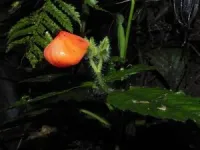(Press-News.org) One of the most notorious mass extinction events in modern times occurred on a hilltop in coastal Ecuador in the 1980s. Ninety species of plants known from nowhere else on Earth—many of them new to science and not yet given a name—went extinct when the last cloud forests of the Centinela range were cleared for agriculture. The cautionary tale of Centinela has long been a driving force in the fight to save the world’s rainforests. But did it really happen?
In a new study published in Nature Plants, an international team of botanists reveals that, indeed, it did not happen. The researchers – who spent years of scouring natural history museums, biodiversity databases, and the slopes of Centinela – found no proof of any extinctions, but abundant evidence that Centinela’s flora lives on in the scattered remaining fragments of coastal Ecuador’s forests.
“It’s a miracle,” said lead author Dawson White, postdoctoral researcher in the Department of Organismic and Evolutionary Biology at Harvard. “Many of Centinela’s plants are still on the brink of extinction, but fortunately the reports of their demise were exaggerated. There’s still time to save them and turn this story around.”
The study revealed that one reason earlier researchers overstated the likelihood of extinction at Centinela was due to the fact that those researchers were collecting a bounty of new and undescribed species, with limited information on which plant species grow where in the world’s most diverse forests. In the decades since, those early collections have provided more than 50 new species. As well, as botanists began to collect more widely and natural history museums digitized their specimens, plants previously thought to have gone extinct at Centinela have turned up at other sites in South America, while others were relocated in situ by the team. Of the 90 species originally presumed extinct, only one has not yet been rediscovered or confirmed to grow elsewhere.
“Understanding which plants are growing in a given Andean cloud forest is a monumental task because you will undoubtedly find new species”, said White. “What our investigation highlights is that it takes decades of work from taxonomic experts to describe new species in such forests. And only once we have names for these species that are then noted in our scientific networks can we begin to understand where else these plants grow and their risk of extinction.”
Ecuador, though small, is incredibly diverse, offering a good illustration of how challenging it is for scientists to monitor and protect tropical biodiversity. It contains more than 20,000 plant species, 4,000 of which occur nowhere else on Earth, hundreds of which lack names, and none of which have been fully mapped. Given these challenges, the study highlights the vital role of herbaria collections.
“Herbaria give us the fundamental ‘what’ and ‘where’ of plant biodiversity,” said co-author Juan Guevara, Universidad de Las Américas in Quito. “They are what made it possible to solve this mystery. They’re the basis of everything we know about which plants are threatened with extinction.”
The authors also found that Centinela’s forests are more resilient than originally thought. Recent field work has pinpointed a number of fragments of original forest that were previously overlooked due to their tiny sizes and remote locations. The team found these postage-sized remnants, often less than an acre in size, to harbor many species thought to have gone extinct—including Gasteranthus extinctus, a wildflower named after its own extinction that was rediscovered by the team in 2021.
“Over the last two years we’ve surveyed a dozen fragments in the region,” said co-author Andrea Fernández, Northwestern University and the Chicago Botanic Garden. “They’re tiny islands lost in a sea of plantations, but they’re still full of astonishing plants.”
Not only were the researchers surprised to find much of the old Centinela flora intact, they were doubly surprised to discover a bounty of new and previously undescribed plants as well. Over the past five years the researchers have described or discovered eight new species ranging in size from miniscule wildflowers to towering canopy trees.
“One of our most astonishing discoveries is a totally new species of canopy tree in the Cotton family,” said Fernández. “It’s one of the tallest trees we have encountered, but it’s extremely rare; there could be only 15 individuals alive in Centinela. It’s now being actively targeted by local loggers-, s-o we are rushing to describe this new tree species and get its seeds growing in botanic gardens.”
Once given a wide berth because of its gloomy past, Centinela is now buzzing with scientists who see in its decimated forests abundant opportunities for research and conservation. In Ecuador, botanical gardens are establishing collections of the region’s rarest, most threatened plants, while conservationists collect seeds for future reforestation efforts and look for long-term solutions to keep the remaining fragments standing. At the global scale, the resurrection at Centinela has inspired the launch of a new conservation initiative by Earth imaging company Planet Labs, which promises to boost conservation projects with high-quality satellite imagery.
While the new study corrects the record on one mass extinction event, it does not cast doubt on the biodiversity crisis underway around the world. According to the IUCN Red List, more than 45,000 species on Earth are currently threatened with extinction, including nearly half of all amphibians, a third of all corals, and a quarter of all mammals. Scientists at Kew Botanical Gardens curated a list of the more than 800 plant species presumed to have gone extinct to date.
“Plants in coastal Ecuador and a lot of other hard-hit places in the tropics are finding a way to hang on in the last nooks and crannies,” said co-author Nigel Pitman, the Field Museum of Natural History. “They won’t survive for long under those conditions, but we’ve still got time to act before they’re gone forever.”
####
END
About The Study: Among individuals with ulcerative colitis, the allele HLA-DRB1*01:03 was associated with severe ulcerative colitis requiring major operation, hospitalization, and systemic corticosteroid use compared with less severe disease. HLA-DRB1*01:03 has previously been linked to ulcerative colitis incidence. This study supports earlier, targeted genetic studies comparing patients with healthy controls reporting an association with total disease and severe disease requiring colectomy.
Corresponding Author: To contact the corresponding author, Marie Vibeke Vestergaard, MSc, email marievv@dcm.aau.dk.
To access the embargoed study: Visit our ...
Montpellier, France – 15 October 2024. In a captivating Genomic Press Interview published on October 15, 2024, in the peer-reviewed journal Genomic Psychiatry (Genomic Press), Professor Philippe Courtet shares groundbreaking perspectives on suicide prevention and mental health care. As an influential PU-PH (Professeur des Universités-Praticien Hospitalier), he is a Professor of Psychiatry at the University of Montpellier, France, and head of emergency psychiatry at the University Hospital of, Professor Courtet stands at the forefront of ...
Miscarriage, or early pregnancy loss, can have devastating emotional effects, but it is poorly managed in Canada. A review published in CMAJ (Canadian Medical Association Journal) https://www.cmaj.ca/lookup/doi/10.1503/cmaj.231489 provides guidance to physicians on how to diagnose and manage this condition and calls for referral to outpatient early pregnancy assessment clinics (EPACs) as well as a compassionate approach.
October 15 is Pregnancy and Infant Loss Remembrance Day.
Data suggest that 15%–20% of all confirmed pregnancies result in miscarriage, with ...
A joint research group led by Jonghyun Kim and Jun Ohashi of the University of Tokyo has demonstrated that the majority of immigration to the Japanese Archipelago in the Yayoi and Kofun periods (between 3000 BCE and 538 CE) came from the Korean Peninsula. The researchers analyzed the complete genome of a “Yayoi” individual and found that, among the non-Japanese populations, the results bore the most similarity to Korean populations. Although it is widely accepted that modern Japanese populations have a dual ancestry, the discovery provides insight into the details of immigration patterns to the ...
DURHAM, N.C. -- Since 1970, 37 countries have cut the probability of their citizens dying before they reach age 70 in half, a milestone that signals the remarkable progress many countries have made in preventing and treating disease. But a new report argues that this goal isn’t out of reach for any country that chooses to cut its premature mortality, even those afflicted by war or poverty.
The report, published Oct. 14 by The Lancet Commission on Investing in Health, lays out a roadmap for every nation that chooses to do so to cut ...
A team of 50 leading international experts, the Lancet Commission on Investing in Health (CIH), explored this question, resulting in clear, actionable, and achievable measures for achieving this ambitious goal worldwide. Six of the 50 commission members are affiliated with the Bergen Centre for Ethics and Priority Setting in Health (BCEPS), a Norwegian Centre of Excellence based at the University of Bergen, Norway, including BCEPS Director and Professor Ole Frithjof Norheim, BCEPS PhD Research Fellow Sarah Bolongaita, and BCEPS-affiliated researchers Angela Chang (University ...
Copenhagen, Denmark: Wearing a helmet can prevent brain injury and deaths in cyclists, yet many do not wear a helmet. New research presented at the European Emergency Medicine Congress today (Tuesday) suggests that this is largely due to issues of convenience and comfort. [1]
The study also suggests that more adult cyclists would wear helmets if they were encouraged and incentivised to do so, for example if they were provided with a free helmet, education, and periodic reminders.
The research was presented by Dr Steven Friedman, an emergency doctor at Toronto General Hospital and associate professor at the University ...
Copenhagen, Denmark: Half of all patients with sepsis admitted to an emergency medical department died within two years, according to Danish researchers investigating factors that could predict outcomes for these patients.
Dr Finn E. Nielsen, a senior scientist in the Department of Clinical Epidemiology at Aarhus University Hospital, Denmark, told the European Emergency Medicine Congress today (Tuesday) [1] that he and his colleagues examined deaths over a long follow-up period in a prospective study of 714 adult patients admitted to the emergency department with sepsis. Their findings ...
Embargoed for release until 5:00 p.m. ET on Monday 14 October 2024
@Annalsofim
Below please find summaries of new articles that will be published in the next issue of Annals of Internal Medicine. The summaries are not intended to substitute for the full articles as a source of information. This information is under strict embargo and by taking it into possession, media representatives are committing to the terms of the embargo not only on their own behalf, but also on behalf of the organization they represent. ...
St. Louis, MO (October 14, 2024) According to the Centers for Disease Control, nearly 20% of children and teens are considered obese. Research shows it can have a dramatic impact on a variety of health conditions, including arthritis, heart conditions and other metabolic problems, and the American Academy of Pediatrics now recommends early and intensive treatment to combat obesity. Over the last four years, Shriners Children’s St. Louis researchers have been working to develop a new way to prevent the effects of childhood obesity.
Using gene therapy, Shriners Children’s St. Louis Director of Research Dr. Farshid Guilak and Senior Scientist Dr. Ruhang Tang ...






